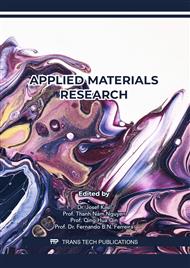[1]
Z. Chen et al., Influence of the pore size and porosity of selective laser melted Ti6Al4V ELI porous scaffold on cell proliferation, osteogenesis and bone ingrowth,, Mater. Sci. Eng. C, vol. 106, Jan. 2020,.
DOI: 10.1016/j.msec.2019.110289
Google Scholar
[2]
N. Wang, J. Y. H. Fuh, S. T. Dheen, and A. Senthil Kumar, Functions and applications of metallic and metallic oxide nanoparticles in orthopedic implants and scaffolds,, J. Biomed. Mater. Res. Part B Appl. Biomater., p. jbm.b.34688, Aug. 2020,.
DOI: 10.1002/jbm.b.34688
Google Scholar
[3]
S. Bose, M. Roy, and A. Bandyopadhyay, Recent advances in bone tissue engineering scaffolds,, Trends Biotechnol., vol. 30, no. 10, p.546–554, Oct. 2012,.
DOI: 10.1016/j.tibtech.2012.07.005
Google Scholar
[4]
N. Wang, S. Maskomani, G. K. Meenashisundaram, J. Y. H. Fuh, S. T. Dheen, and S. K. Anantharajan, A study of Titanium and Magnesium particle-induced oxidative stress and toxicity to human osteoblasts,, Mater. Sci. Eng. C, vol. 117, p.111285, Dec. 2020,.
DOI: 10.1016/j.msec.2020.111285
Google Scholar
[5]
V. Karageorgiou and D. Kaplan, Porosity of 3D biomaterial scaffolds and osteogenesis,, Biomaterials, vol. 26, no. 27. Elsevier BV, p.5474–5491, 2005,.
DOI: 10.1016/j.biomaterials.2005.02.002
Google Scholar
[6]
L. J. Gibson and M. F. Ashby, Cellular Solids,, MRS Bulletin, vol. 28. p.429–450, 1997,.
Google Scholar
[7]
W. E. Frazier, Metal additive manufacturing: A review,, J. Mater. Eng. Perform., vol. 23, no. 6, p.1917–1928, 2014,.
Google Scholar
[8]
F. Matassi, A. Botti, L. Sirleo, C. Carulli, and M. Innocenti, Porous metal for orthopedics implants.,.
Google Scholar
[9]
G. K. Meenashisundaram et al., Fabrication of Ti + Mg composites by three-dimensional printing of porous Ti and subsequent pressureless infiltration of biodegradable Mg,, Mater. Sci. Eng. C, vol. 108, no. July 2019, p.110478, 2020,.
DOI: 10.1016/j.msec.2019.110478
Google Scholar
[10]
S. Jiang, L. J. Huang, Q. An, L. Geng, X. J. Wang, and S. Wang, Study on titanium-magnesium composites with bicontinuous structure fabricated by powder metallurgy and ultrasonic infiltration,, J. Mech. Behav. Biomed. Mater., vol. 81, p.10–15, May 2018,.
DOI: 10.1016/j.jmbbm.2018.02.017
Google Scholar
[11]
Y. Chen et al., Mechanical properties and biocompatibility of porous titanium scaffolds for bone tissue engineering,, J. Mech. Behav. Biomed. Mater., vol. 75, p.169–174, Nov. 2017,.
Google Scholar
[12]
Z. S. Bagheri, D. Melancon, L. Liu, R. B. Johnston, and D. Pasini, Compensation strategy to reduce geometry and mechanics mismatches in porous biomaterials built with Selective Laser Melting,, J. Mech. Behav. Biomed. Mater., vol. 70, p.17–27, Jun. 2017,.
DOI: 10.1016/j.jmbbm.2016.04.041
Google Scholar
[13]
L. Y. Chen et al., Anisotropic response of Ti-6Al-4V alloy fabricated by 3D printing selective laser melting,, Mater. Sci. Eng. A, vol. 682, p.389–395, Jan. 2017,.
DOI: 10.1016/j.msea.2016.11.061
Google Scholar
[14]
A. T. Sidambe, Effects of build orientation on 3d-printed co-cr-mo: Surface topography and l929 fibroblast cellular response,, Int. J. Adv. Manuf. Technol., vol. 99, no. 1–4, p.867–880, 2018,.
DOI: 10.1007/s00170-018-2473-0
Google Scholar
[15]
G. Campoli, M. S. Borleffs, S. Amin Yavari, R. Wauthle, H. Weinans, and A. A. Zadpoor, Mechanical properties of open-cell metallic biomaterials manufactured using additive manufacturing,, Mater. Des., vol. 49, p.957–965, 2013,.
DOI: 10.1016/j.matdes.2013.01.071
Google Scholar


